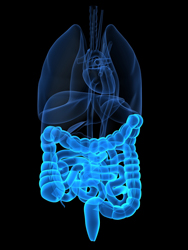Human intestinal tract — understanding from the inside out
Researchers on the 'Metagenomics of the human intestinal tract (METAHIT) project have created a comprehensive reference catalogue to represent microbial genes in the human intestine, or gut. Five-hundred and forty giga base pairs of microbial DNA were sequenced and compared from 124 stool samples of healthy and sick people suffering from IBD or obesity. Genes were catalogued, and gene frequency and expression measured for variations in human intestinal microbiota. A major breakthrough was the finding that humans have three distinct enterotypes with different levels of Bacteroides, Prevotella and Ruminococcus bacteria. Enterotypes were found to be individual-specific with no correlation with age, gender, food, geography or genetic heredity. A database was created to store and organise information generated within and outside the project. METAHIT members developed tools to create gene abundance profiles of the intestinal metagenome to distinguish between healthy, sick and people at high risk of disease. Efforts were made to study the function of bacterial genes and understand host–microbe interactions. A bioinformatics comparison of the bacterial genes present in UC patients, obese patients, and healthy and lean people showed differences in bacterial species and composition. Further studies are required to confirm and validate results. METAHIT scientists found dependency sub-networks between certain metagenomic units (MGUs) and metagenomic species (MGS) that could have genetic associations to disease using a co-abundance clustering approach. Previous studies showed that a tendency to obesity could be partly attributed to genetic heredity. Quantitative metagenomic analysis of 292 Danish individuals showed that microbial genome variation may play a role in obesity. Enterotype distribution varied greatly between low gene count (LGC) and high gene count (HGC) individuals. More LGC cases had Bacteroides-driven enterotype 1, whereas a higher percentage of HGC individuals were enterotype 3. Reference genome mapping with gene abundance data at phylum, genus and species levels was carried out to assess differences in microbial communities.HGC individuals had higher distribution of anti-inflammatory species such as Faecalibacterium prausnitzii and Roseburia inulinivorans. LGC individuals had higher levels of Bacteroides and Rumnicoccus gnavus that are pro-inflammatory and associated with IBD. Decisive-Bacterial-Abundance score, receiver-operator characteristic (ROC) analysis and area under curve values helped distinguish between bacterial species present in LGC and HGC individuals. LGC cases were found to have higher fat levels and higher risk of developing prediabetes, type 2 diabetes and ischaemic cardiovascular disorders. Sensitive Q-PCR technology for quantitative metagenomics analysis of gut microbiota was used for enterotype stratification to differentiate lean from obese individuals and other pathologies based on different metabolic risk profiles. This revealed the potential for commercial development of personalised medicine using microbiota analysis and stratification. Project results were disseminated through publications, websites, YouTube, Facebook, conferences and Twitter to increase public knowledge and attract investors. Successful project outcomes could result in the commercial development of novel technologies for diagnosis and therapy of IBD, obesity and metabolic disorders.



